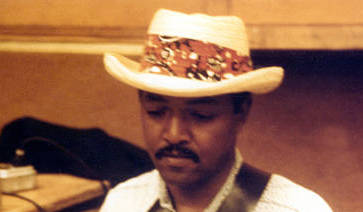Bassist James Jamerson was the bedrock of Motown Records’ legendary studio band the Funk Brothers, between 1959 and 1973 playing on no fewer than 23 Billboard Hot 100 number one hits as well as 56 Billboard R&B chart-toppers. Famed for his inventive, deeply melodic rhythms, Jamerson was largely unsung during his brief lifetime, but he was declared the greatest bass guitarist of all time in 2017 by Bass Player magazine, earning the same honorific in 2020 from Rolling Stone. Explore Jamerson’s indelible contributions to the Motown Sound via the playlist below.

“Shotgun” (1965) – KORD-0014
“Shotgun” is the Motown classic that sounds nothing at all like a Motown classic. Junior Walker and the All Stars’ roadhouse R&B juggernaut is untamed and unbound — a wild card in a catalog synonymous with sequinned style and silk-trimmed sophistication. Motown founder Berry Gordy Jr. produced “Shotgun,” which augmented the core All Stars lineup with Funk Brothers mainstays including Jamerson, guitarist Eddie Willis, Hammond organ player Johnny Griffith and percussionist Jack Ashford. “Shotgun” is first and foremost a showcase for Walker’s fire-breathing tenor saxophone and nonsensical, raw-throated shouts (“We gonna dig potatas! We gonna pick tomatas!”), but the single’s simplicity and spontaneity belie its experimental streak. For starters, the blast of gunfire that opens “Shotgun” isn’t gunfire at all — it’s a heavily echoed and compressed recording of Willis accidentally kicking his guitar amplifier. Then there’s the song’s unusual structure, which eschews typical progressions in favor of hammering the same Ab7 chord throughout. Pioneering minimalist composer Steve Reich later cited “Shotgun” as an influence on mid-1960s landmarks like It’s Gonna Rain and Come Out, singling out Jamerson’s rock-steady contributions in the process. “I was getting interested in what you could call harmonic stasis — not having a whole lot of harmonic change,” Reich told Tape Op in a 1999 interview. “You found this also in the pop world. I don’t know if you remember back to Motown, but Junior Walker had a big hit tune called ‘Shotgun’… Basically the bassline just went [sings bassline] and it just went like that over and over again. It had no ‘B’ section, no break or release.”

“I Heard It Through the Grapevine” (1968) – KORD-0027
With “I Heard It Through the Grapevine,”the confessional account of a man devastated to learn through the rumor mill of his lover’s infidelity, singer Marvin Gaye and producer Norman Whitfield created what is quite possibly the greatest single in the Motown canon. Whitfield’s simmering production is somehow both spacious and claustrophobic at the same time, perfectly conveying the tortured psyche of a man gasping for air and grasping for terra firma as gossip swirls around him. The Funk Brothers ratchet up the tension: Jamerson’s foreboding bassline is the record’s indelible signature, but Griffith’s funereal Wurlitzer and Richard “Pistol” Allen’s warlike tom toms are no less essential to the underlying melancholy and menace. (The same goes for Ashford’s tambourine, which slithers like a rattlesnake winding through the Garden of Eden.) Paul Riser’s string arrangement is another marvel: the punctuations of the Detroit Symphony Orchestra serve notice that “I Heard It Through the Grapevine” is an altogether different kind of Motown record, one that is more sophisticated — more frankly adult — than anything the label had previously attempted. Last but certainly not least is Gaye himself: “[Whitfield] set the song in a key that was beyond the singer’s natural range, so that he had to strain to reach the notes,” writes Peter Shapiro in his book Turn the Beat Around: The Secret History of Disco. “The result was the greatest performance of Gaye’s career, unifying all of his gospel training and earthy sensuality in one sustained cry of desperate passion.”

“I Can’t Get Next to You” (1969) – KORD-0083
“I Can’t Get Next to You” is on paper an archetypal Temptations single — a clever, colorful spin on unrequited romance spotlighting the extraordinary range of the quintet’s individual voices, from the depths of Paul Williams’ baritone to the preposterous heights of Eddie Kendricks’ falsetto — but Whitfield’s audacious production is a different matter altogether. The record begins with the sound of applause (later sampled in another Whitfield-produced Temptations hit, “Psychedelic Shack”) before Dennis Edwards hushes the audience, entreating them (and us) to “Hold it, hold it, listen.” A snatch of twinkling, late-night piano immediately follows, and then the music absolutely erupts — blasts of brass make way for a dazzlingly complex web of percussion dominated by Jamerson’s tightrope-taut bassline and Dennis Coffey’s metronomic, chicken-scratch guitar. “I Can’t Get Next to You” was the result of no fewer than six recording sessions between June 23 and July 3, 1969: “I was always the guy with the highest cutting percentage in the world, mainly because I would just go after that hit record,” Whitfield told the BBC for its 1984 documentary The Story of Motown. “If I could get that hit record in 45 minutes or maybe an hour and a half, I would just let the musicians go. Most of the time, Berry [Gordy] would want people to go in and cut as many sides as they could in those three hours, because it was a matter of union scale and [recording] date. I would just devote my time to making sure I got the hit. I could always fill the album with different types of songs and stuff, but that hit record was the key. It was the vehicle in terms of selling the album, and selling the act.”

“What’s Going On” (1971) – KORD-0050
Berry Gordy conceived Motown as a paragon of integration and inclusion, a hit factory producing music for audiences of all races and creeds — and to that end, Motown in its early years assiduously avoided overt political statements. “What’s Going On” wasn’t the first Motown hit to challenge Gordy’s mandate, but it was the most impactful, condemning America’s ongoing involvement in the Vietnam War by spotlighting the conflict’s effects on the lives of both the young men sent overseas and the families they left behind. The Four Tops’ Renaldo “Obie” Benson penned the first version of “What’s Going On” after witnessing a police attack on antiwar protesters; when the other members of the venerable vocal quartet declined to record the song, Benson presented it to Gaye, who added a new melody and new lyrics, drawing inspiration from the wartime experiences of his brother and cousin (the latter one of the more than 58,000 Americans killed in combat). The resulting single, which Gaye produced himself, is both searing and soaring, a gospel-inspired celebration of peace, love and understanding in the face of American brutality and bloodlust.
According to legend, Jamerson recorded his complex, nuanced “What’s Going On” bassline after Gaye located him playing with a band at a Detroit bar; unable to sit properly in his seat, an inebriated Jamerson cut the session while laying on the floor of Motown’s Hitsville USA studio. “He just read the [bass] part down like I wrote it,” Motown arranger and conductor David Van De Pitte said later. “He loved it because I had written Jamerson licks for Jamerson.” Annie Jamerson, the bassist’s widow, also recalled that when Jamerson returned home following the “What’s Going On” session, he declared the recording a “masterpiece.” And for his work on Gaye’s landmark What’s Going On album, he was celebrated in the sleeve notes as “the incomparable James Jamerson” — the first time he was ever credited on a major Motown release.







